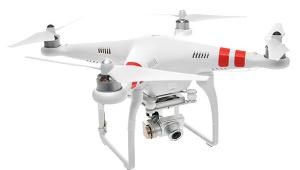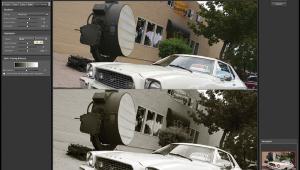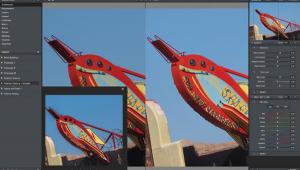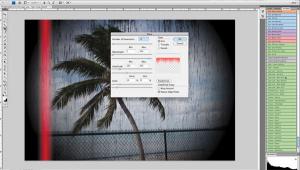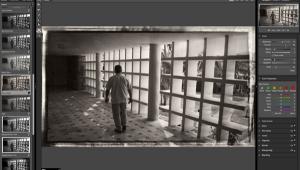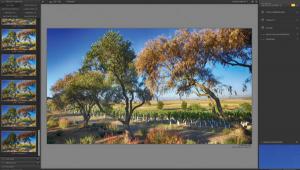Controlling The Image With Hardware & Software: Items That Add An Extra Touch
During a portrait session and perhaps to a lesser extent when shooting a wedding, you can control the lighting, background, and subject. During a portrait session, I try to manage everything from the subject’s pose, clothing, and makeup and the resulting photographs tend to be as much a portrait of me as they are of my subject. What often emerges from that control is a style, which is not something I’m conscious about when photographing, but the truth is that over time we all develop a signature way of shooting. The danger is that we keep shooting that same way or different versions of the same shot for the rest of our lives. Any style you develop must grow and change as you learn. Otherwise, what’s the point? As we continue to shoot and learn from experience, and reading magazines like Shutterbug, we start to tweak and improve those results until what emerges is truly a personal style.

Perfect Portraits
In January, I introduced you to onOne Software’s (www.ononesoftware.com) Perfect Photo Suite 6 and, because this is the wedding and portraiture issue, I want to highlight their Perfect Portrait plug-in that is (dare I say it) perfect for wedding photographers. It’s a new retouching product from onOne that provides the tools for reducing blemishes as well as enhancing eyes, lips, and teeth. More than just finding each face, Perfect Portrait automatically locates the subject’s eyes and mouth in a portrait. It works as a stand-alone application or directly from within Apple’s Aperture or Adobe’s Lightroom or Photoshop, which is how I use it. A Retouch Brush lets you remove acne, stray hairs, veins, or other large blemishes. Just dab the brush on a subject’s blemish (high school senior photographers, take note) and it’s gone. The software uses SkinTune technology to adjust color based on the skin color and ethnicity for each face in the photograph. Perfect Portrait is available as part of Perfect Photo Suite 6 or by itself for $99.95.

Silver Shadows Presets For Lightroom
Silver Shadows 2 (SS2) is a collection of presets for Adobe’s Lightroom from Seim Effects (http://prophotoshow.net/seim_effects) that provides precise control of tones, shadows, highlights, and delicate tonality. SS2 is an organized system for making black-and-white images and includes more than 100 refined tools that you can mix and match, customize, or tweak right on the original file, all without the hassle of leaving Lightroom. While SS2 is designed for Lightroom, Gavin Seim told me if Aperture users are interested in a dedicated Silver collection to let him know. As I write this you can purchase SS2 for the introductory price of $45. Current Silver Shadows users can upgrade for just $20. If you want to check out SS2, download the free sampler pack and take a look.

Holder-Mounted Hitech Filters
Hitech makes high-quality modular filters and have re-priced their line, making them competitive with less expensive resin filters. Their ND filters are part of a system that is said to offer a greater range of densities, with finer increments of density, than screw-in glass equivalents. Hitech is manufactured in Great Britain and distributed in the U.S.A. by Visual Departures, Ltd. (www.visualdepartures.com) and uses resin produced in-house that’s hard, scratch-resistant, and easy to clean.
Hitech ND filters are available in a third-stop of density steps up to five stops, then in six-, seven-, eight-, nine-, and 10-stop densities. Hitech’s 85mm filters are compatible with Cokin’s P-sized holders and their 100mm (4x4”) filters fit Lee holders of the same size. Six- through 10-stop ND filters are available in their ProStop line with a thicker gasket to fit the wider slots of Lee’s holders. Hitech also makes a range of reverse-graduated ND filters with the heaviest density at the center of the filter, lightening toward the top. Hitech’s reverse-graduated ND filters are available in one-, two-, and three-stop densities or as a kit with all three.

Retrographer Photoshop Plug-In
Mister Retro’s (www.misterretro.com) Retrographer is a Photoshop-compatible plug-in that lets you create classic photographic effects. More than 1100 preset camera settings and millions of possible combinations are packed into an easy to use but alas not resizable interface that offers more than 15 vintage photography categories of effects, including Processing, Photo Lab, Aging, Light Leaks, Vignetting, Halftone, Lens Focus, Lens Gel, Framing, Surface, Flash Hotspot, Lens Distortion, Camera Flash, Tonal Film Stocks, and Film Grain. My favorite is the Colored Flash effect that senior portrait photographers will love. The plug-in’s interface includes a processing lab tab that utilizes presets but has a full set of sliders that let you tweak filter intensity, color, luminosity, and lots more. Retrographer costs $99 and lets you re-create any old timey-looking camera look, including Lomo, Dianne, Holga, Polaroid, Brownie, Kodak, and even Daguerreotype.
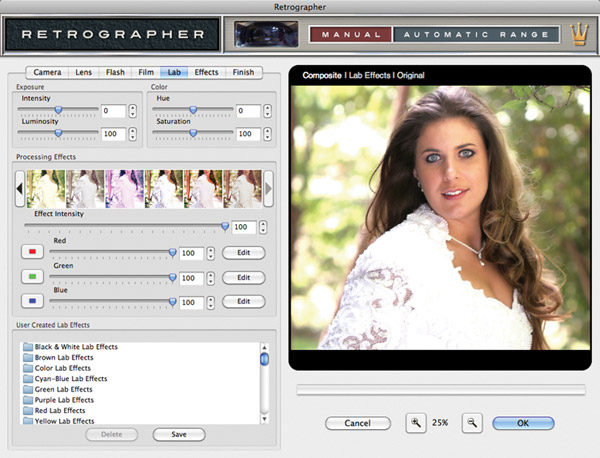
Sneak Peek At Topaz Adjust 5
Topaz Adjust from Topaz Labs (www.topazlabs.com) is one of my favorite effects plug-ins and as we went to press I had a chance to explore a beta copy of Version 5. The final version will be available when you read this. Adjust 5 is enhanced with the tools needed for a professional and streamlined workflow, including the ability to automatically create a new layer where adjustments can be saved. You can also stack multiple effects and presets while using the same workflow.
New collections contain more than 100 presets, offering everything from subtle photo pops and warm/cool adjustments to HDR effects to film effects. You can save your favorites under My Collection. Local Adjustments can be made on the right-hand side of the interface with intuitive selective adjustments for burning, dodging, smoothing, and brushing out (erasing). A Histogram shows your image’s tonal range and a built-in Curve tool lets you adjust tonality to emphasize tones, contrast, and brightness. Also on the right side is a Finishing Touches tab with options for diffusion, grain, borders, vignettes, tonal adjustments, and overall transparency. There are clickable preview options that allow you to hide or view adjustments for easy comparison as well as a screen split view for before and after comparisons.

App Of The Month
There is no doubt that apps are big business and photographers, including my friend Rick Sammon, have created apps as well as established software companies, such as Adobe. Starting this month, I’ll pick a photo-oriented app to showcase in this column. If you have a favorite app you would like to share with Shutterbug readers, please drop me an e-mail via the Contact page of my website (http://joefarace.com).
My favorite photo app is Instagram (http://instagr.am) for the iPhone. It’s a free download from Apple’s App Store and an Android version has long been expected but is not available as I write this. Instagram’s concept is simple, yet fun: it lets you capture an image and then enhance it using a bunch of built-in filter effects, then share the photo with others via Facebook, Twitter, Flickr, or you can directly “follow” an Instagram shooter much as you can on any of those social networks. You can even follow me on Instagram and see the occasional snapshots I make when traveling. Read more about the app on its blog (http://blog.instagram.com). Instagram is an incredibly addictive app and lots of fun to use. Give it a try and you’ll be hooked.

- Log in or register to post comments
